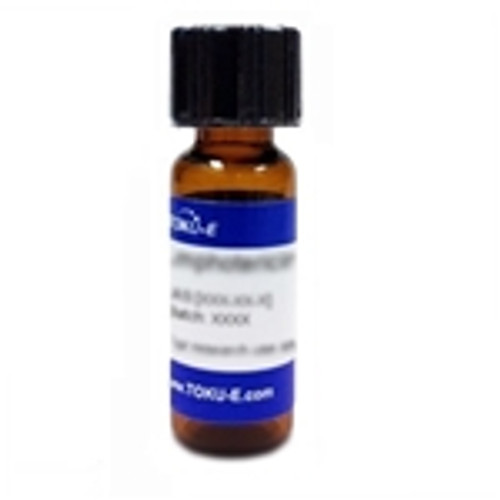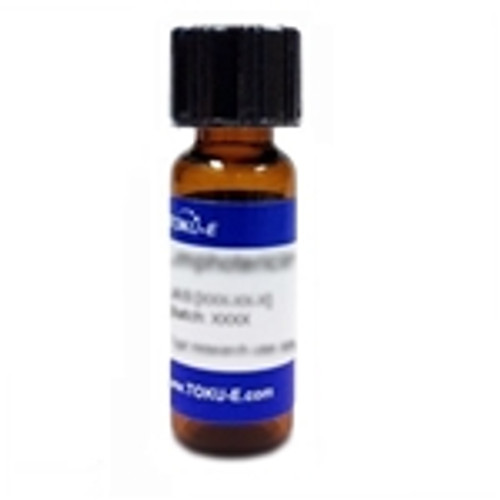Teicoplanin (syn: Targocid, Teichomycin) is a lipoglycopeptide complex first reported from Actinoplanes teichomyceticus in 1978. Teicoplanin is a mixture of several compounds including five major compounds (Teicoplanin A2-1 through A2-5), and four minor compounds or 'related substances' (Teocoplanin RS1 through RS4). All Teicoplanin compounds share the same glycopeptide core, termed Teicoplanin A3-1, a fused ring structure to which two carbohydrates (mannose and N-acetylglucosamine) are attached.
Teicoplanin has a similar spectrum of activity as vancomycin and is effective against Gram-positive bacteria, including methicillin-resistant Staphylococcus aureus (MRSA) and Enterococcus faecalis.
Teicoplanin is a cell wall synthesis inhibitor that works by inhibiting peptidoglycan synthesis and polymerization in two ways. One mechanism inhibits N-acetylmuramic acid (NAM) and N-acetylglucosamine (NAG) from coming together to form the peptidoglycan backbone. Another mechanism prevents cross-linking between amino acid residues in the peptidoglycan chain.
Teicoplanin is sparingly soluble in water.
- For more Teicoplanin products click here.
| Mechanism of Action | Teicoplanin prevents peptidoglycan synthesis and polymerization by two separate mechanisms. One mechanism prevents N-acetylmuramic acid (NAM) and N-acetylglucosamine (NAG) from linking together forming the peptidoglycan backbone. The second mechanism prevents cross-linking between amino acid residues in the peptidoglycan chain. This mechanism is nearly identical to vancomycin; however, teicoplanin is considered a safer compound due to its lower nephrotoxicity and ototoxicity. |
| Spectrum |
Teicoplanin targets primarily Gram-positive bacteria especially those resistant to methicillin. These include the drug resistant superbug, MRSA (Methicillin resistant Staphylococcus aureus) and Enterococcus faecalis. Teicoplanin is effective for treating MRSA infections because it inhibits cell wall synthesis through a different mechanism than β-lactam antibiotics. Teicoplanin is similar but not identical to vancomycin in its spectrum of activity. The MICs for most Gram-positive bacteria and anaerobes are comparable, but Teicoplanin is less active against some strains of Staphyloccus haemolyticus (MIC 16–64 mg/L compared to ≤4 mg/L for vancomycin). Both VanA-type VRE and VISA isolates are also resistant to Teicoplanin. |
| Impurity Profile | Impurity A| 4-methylpent-3-en-2-one(mesityl oxide)|141-79-7|C6H10O|98.14| |
| Microbiology Applications | Teicoplanin is commonly used in clinical in vitro microbiological antimicrobial susceptibility tests (panels, discs, and MIC strips) against Gram-positive isolates. Medical microbiologists use AST results to recommend antibiotic treatment options. Representative MIC values include:
For a representative list of Teicoplanin MIC values, click here. |
| Molecular Formula | A2-1 (CAS 91032-34-7) C88H95Cl2N9O33|1877.64| A2-2 (CAS 91032-26-7) C88H97Cl2N9O33|1879.65| A2-3 (CAS 91032-36-9) C88H97Cl2N9O33|1879.65| A2-4 (CAS 91032-37-0) C89H99Cl2N9O33|1893.68| A2-5 (CAS 91032-38-1) C89H99Cl2N9O33|1893.68| A3-1 (CAS 93616-27-4) C72H68Cl2N8O28|1564.25| A3-2 (CAS 91032-39-2) C66H58Cl2N8O23|1402.11| |
| Elemental Analysis | Composition: Teicoplanins A2: ≥80.0% Teicoplanins A3: ≤15.0% Other Impurities: ≤5.0% |
| References |
Joshi S et al (2013) Methicillin-resistant Staphylococcus aureus (MRSA) in India: Prevalence & susceptibility pattern. Indian J. Med. Res. 137(2):363-369 Murphy S and Pinney RJ (2008) Teicoplanin or vancomycin in the treatment of Gram–positive infections?" J. Clin. Pharm. and Therapeutics 20(1):5-11 |
| MIC | Bacillus spp.| 2|| Bacillus subtilis| ≥12.5|| Bacteroides distasonis| ≥16|| Bacteroides fragilis| 8 - ≥16|| Bacteroides ovatus| >16|| Bacteroides thetaiotaomicron| >16|| Bacteroides uniformis| >16|| Bacteroides vulgatus| >16|| Bifidobacterium spp.| ≤0.06 - 0.5|| Borrelia burgdorferi S.L.| 2 - >8|| Brevibacterium spp.| 0.25 - 1|| Clostridium bifermentans| ≤0.06 - 4|| Clostridium cadaveris| ≤0.06 - 4|| Clostridium difficile| 0.06 - 0.5|| Clostridium histolyticum | ≤0.06 - 4|| Clostridium paraputrificum| ≤0.06 - 4|| Clostridium perfringens| ≤0.03 - 0.25|| Clostridium ramosum| ≤0.06 - 4|| Clostridium sordellii| ≤0.06 - 4|| Clostridium spp.| ≤0.03 - 8|| Clostridium tertium| ≤0.06 - 4|| Corynebacterium afermentans| 0.25 - 1|| Corynebacterium amycolatum| 0.12 - 0.5|| Corynebacterium jeikeium| 0.12 - 4|| Corynebacterium minutissimum| 0.25 - 0.5|| Corynebacterium pseudodiphtheriticum| 0.12 - 2|| Corynebacterium spp.| ≤0.12 - 0.5|| Corynebacterium striatum| 0.12 - 0.5|| Corynebacterium urealyticum| 0.25 - 0.5|| Coryneform| 0.25 - 1|| Eggerthella lenta| 0.06 - 0.5|| Enterococcus avium| ≤0.12 - >16|| Enterococcus casseliflavus| ≤0.12 - >16|| Enterococcus durans| ≤0.12 - >16|| Enterococcus faecalis| 0.01 - 512|| Enterococcus faecium| 0.01 - >128|| Enterococcus gallinarum| ≤0.12 - >16|| Enterococcus hirae| ≤0.12 - >16|| Enterococcus mundtii| ≤0.12 - >16|| Enterococcus raffinosus| ≤0.12 - >16|| Enterococcus spp.| ≤0.12 - 512|| Erysipelothrix rhusiopathiae| 16|| Escherichia coli| 12.5|| Eubacterium spp.| ≤0.06 - 0.125|| Finegoldia magna| 0.125 - 0.25|| Fusobacterium mortiferum| >16|| Fusobacterium necrophorum| >16|| Fusobacterium nucleatum| ≥16|| Fusobacterium spp.| ≥16|| Fusobacterium varium| ≥16|| Lactobacillus spp.| 0.25 - >16|| Leuconostoc spp.| >16000|| Listeria monocytogenes| 0.25 - 0.5|| Listeria spp.| 0.25 - 0.5|| Micromonas micros| 0.125 - 0.5|| Oerskovia spp.| 0.25 - 1|| Peptostreptococcus anaerobius| ≤0.006 - 0.25|| Peptostreptococcus asaccharolyticus| ≤0.006 - 0.25|| Peptostreptococcus magnus| ≤0.006 - 0.25|| Peptostreptococcus micros| ≤0.006 - 0.25|| Peptostreptococcus prevotii| ≤0.006 - 0.25|| Peptostreptococcus tetradius| ≤0.006 - 1|| Porphyromonas asaccharolytica| ≤0.06 - >16|| Porphyromonas gingivalis| ≤0.06 - >16|| Porphyromonas spp.| ≤0.06 - >16|| Prevotella bivia| 1 - 4|| Prevotella buccae| ≤0.06 - >16|| Prevotella corporis | ≤0.06 - >16|| Prevotella disiens| ≤0.06 - >16|| Prevotella intermedia| 0.125 - 2|| Prevotella loescheii| ≤0.06 - >16|| Prevotella melaninogenica| 14 - 4|| Prevotella oralis (group)| ≤0.06 - >16|| Prevotella oris| ≤0.06 - >16|| Prevotella spp.| ≤0.06 - >16|| Prevotella/Porphyromonas spp.| 0.125 - 8|| Propionibacterium acnes| 0.25 - 0.5|| Pseudomonas aeruginosa| 0.8 - 25|| Rhodococcus equi| 0.12 - 0.25|| Staphylococcus aureus| ≤0.06 - ≥128|| Staphylococcus auricularis| ≤2 - >16|| Staphylococcus capitis| 0.25 - >16|| Staphylococcus chromogenes (coagulase-negative)| 0.25 - 8|| Staphylococcus cohnii| ≤2 - >16|| Staphylococcus epidermidis| ≤0.06 - 32|| Staphylococcus haemolyticus| ≤0.12 - >64|| Staphylococcus hominis| 0.25 - >16|| Staphylococcus lugdunensis| ≤2 - >16|| Staphylococcus saprophyticus| 0.25 - >16|| Staphylococcus sciuri| ≤2 - >16|| Staphylococcus simulans| ≤2 - >16|| Staphylococcus warneri| 0.25 - >16|| Staphylococcus xylosus| ≤2 - >16|| Streptococcus agalactiae| ≤0.008 - 0.25|| Streptococcus faecalis| ≥12.5|| Streptococcus intermedius| ≤2 - >16|| Streptococcus pneumonia| ≤0.008 - 1|| Streptococcus pyogenes| ≤0.008 - 0.25|| Turicella otitidis| 0.25 - 1|| |








